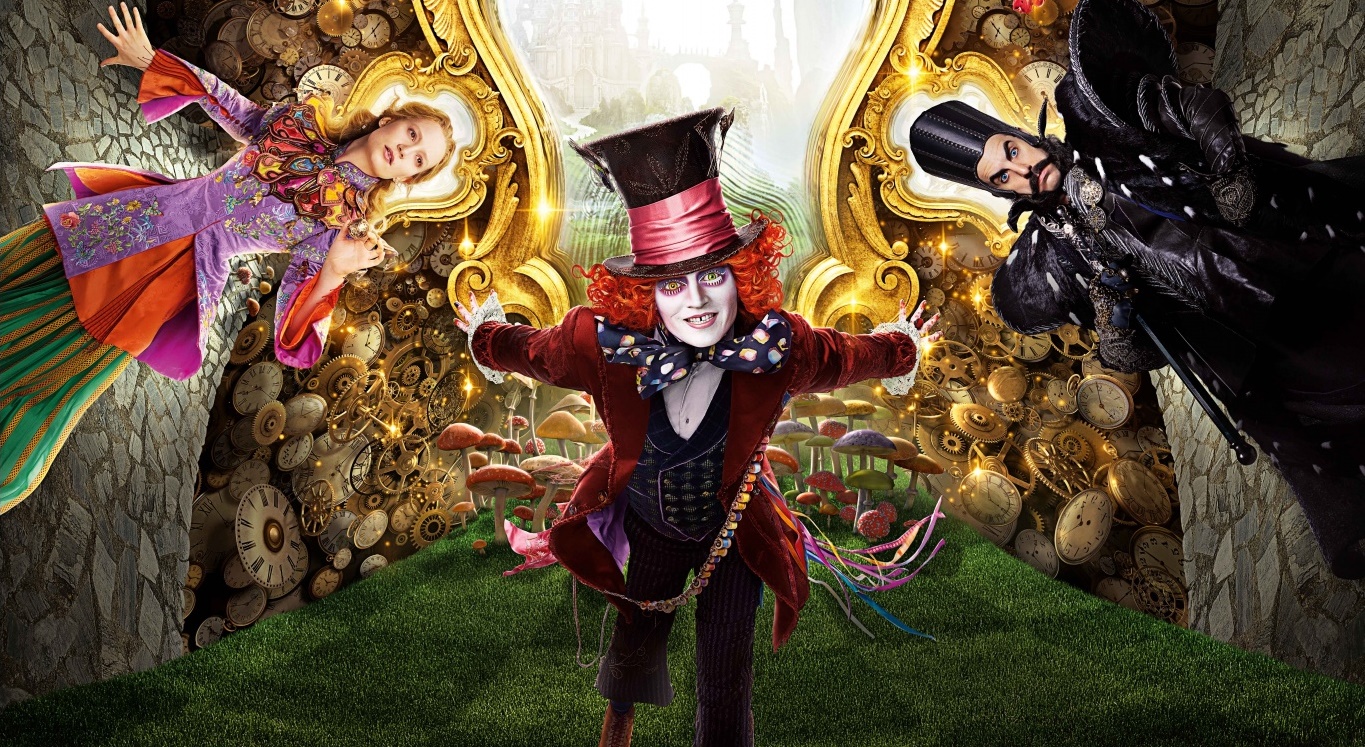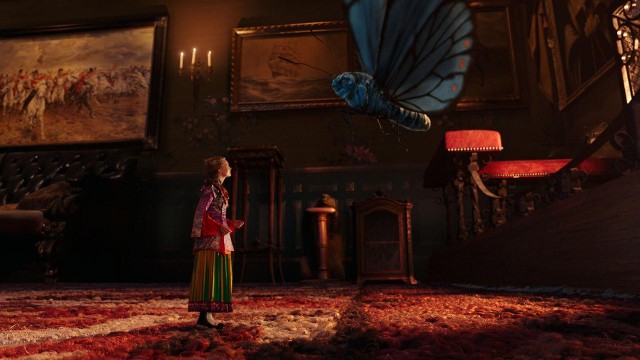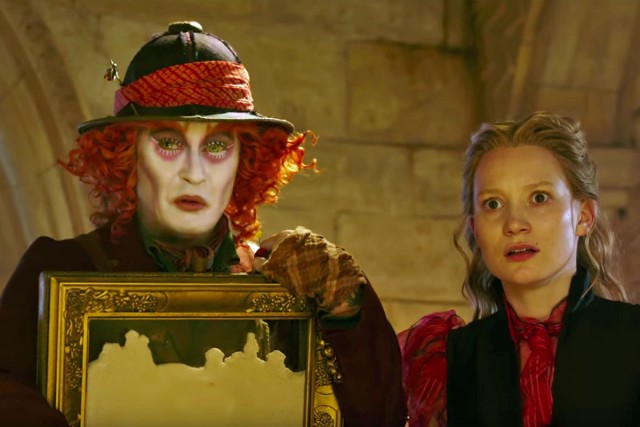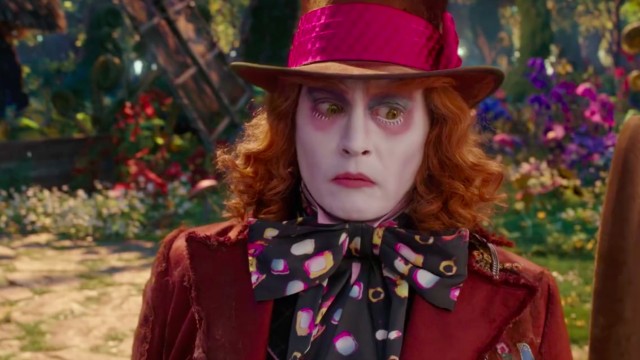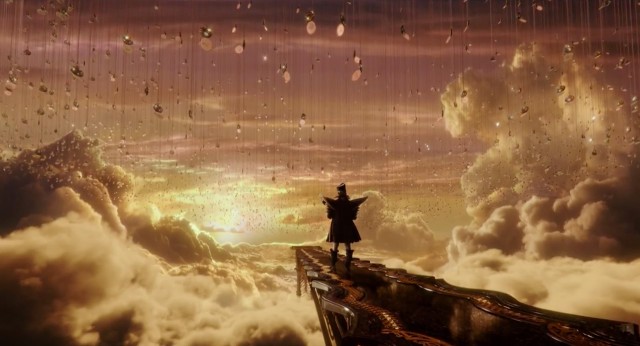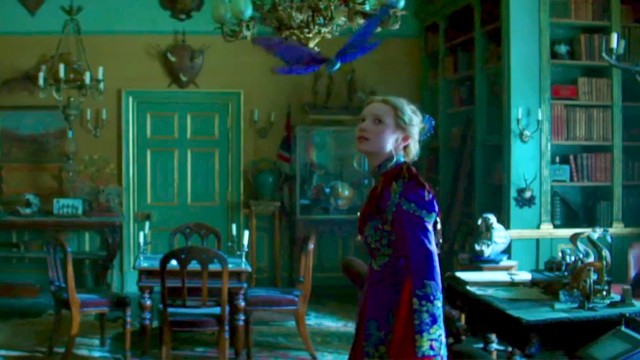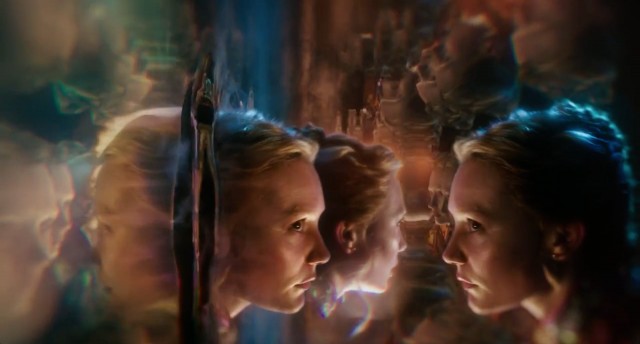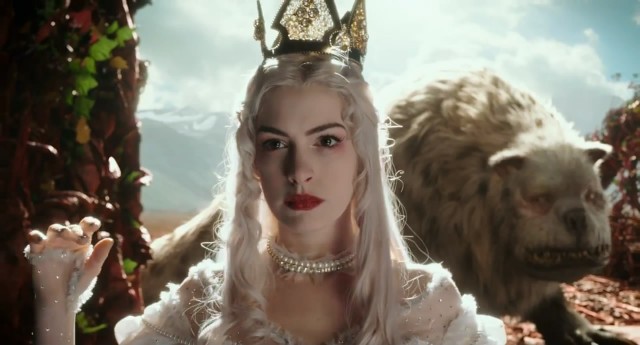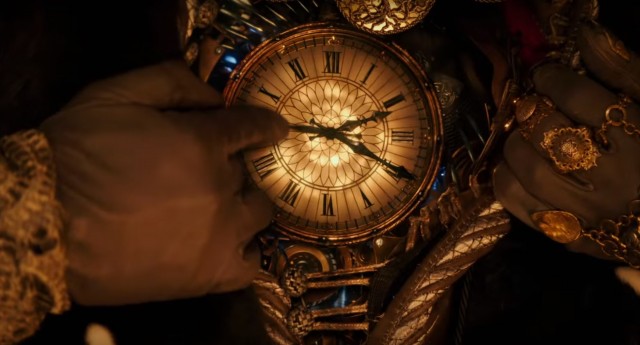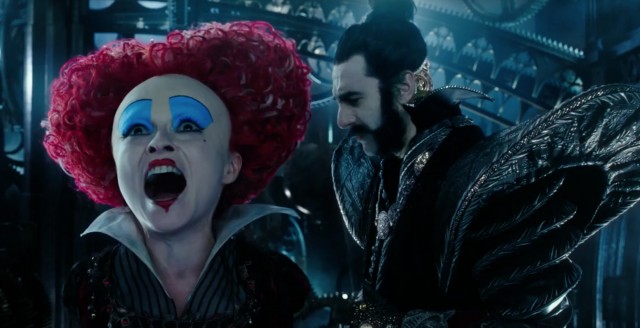Confounding the critics, Tim Burton’s 2010 live-action take on Alice in Wonderland went on to gross over $1 billion at the worldwide box office. Considering that massive haul, Disney quickly got to work on preparing a sequel to the movie, with most of the original actors returning, alongside some new faces. That sequel borrowed the title of author, Lewis Carroll’s original follow-up book to Alice’s Adventures in Wonderland, Through the Looking Glass, and has finally made its way to the big screen!… Six years later.
The fact that a Disney sequel took six whole years to hit theatres is a pretty big red flag for Alice Through the Looking Glass (not that the same sign will deter next year’s oft-delayed Pirates of the Caribbean: Dead Men Tell No Tales), and the switch in directors from Tim Burton, who merely stays on as a producer this time, to The Muppets and Muppets Most Wanted director, James Bobin, definitely suggests that Disney agreed with some of the feedback from 2010’s Alice in Wonderland, namely that it was too dark. For what it’s worth, Alice Through the Looking Glass does at least do a better job of appealing to Disney’s usual family-friendly audience, and should make for a satisfactory Memorial Day weekend option for American families, even with the stiff competition of 20th Century Fox’s X-Men: Apocalypse opening that same weekend in domestic territories.
Unfortunately though, Alice Through the Looking Glass’s long development cycle is very evident, and the movie doesn’t really provide a satisfactory follow-up to its already shaky predecessor, at least when it comes to personality and storytelling. Alice Through the Looking Glass is undeniably gorgeous, and it’s a visually dazzling movie in its IMAX 3D cut especially, but much of the movie sadly amounts to a bunch of visual gloss with barely anything under the hood to satisfyingly tie it all together.
Mia Wasikowska once again leads proceedings as Alice Kingsleigh, the adult variation on the classic protagonist from Lewis Carroll’s Wonderland-themed stories. Now a female ship captain in the 19th Century (pretty improbable, but it does directly carry over from the ending of 2010’s Alice in Wonderland), Alice once again finds herself returning to Wonderland after another personal crisis. Considering the events of the first movie though, Wasikowska has already used up most of her quotient of wonder and intrigue. Further hurting her returning protagonist is that she’s seemingly playing an edgier Alice in a more light-hearted movie, which makes Alice feel like a bland, disappointing lead, even when she’s supposed to be empowering and independent.
Similarly, many of the other returning actors are given disappointingly little to do in this follow-up. Characters like the Bandersnatch, Tweedledee and Tweedledum, and White Queen, Mirana show up again, but mainly to serve exposition or throwaway jokes. The one returning character from Wonderland who actually is given proper story development is Johnny Depp’s Mad Hatter, who is slowly losing his spirit and fading away, since he has discovered evidence that his missing family could have survived the Jabberwocky attack that was mentioned in the first movie, but no one believes him, not even Alice. Most of the movie’s storyline now centers around saving the Mad Hatter as a result, another character who is trying to be made darkier and edgier when the rest of the movie around him is becoming more light-hearted. It’s very odd, and not in a good way.
Fortunately, the major new personality in the movie, Time, played by Sacha Baron Cohen, is one of the movie’s best personalities. Eccentric, impatient and just a little oblivious, Time’s scenes represent the portions of Alice Through the Looking Glass actually achieving an inspired and clever vision, even having barely anything to do with the source novel, beyond a few Easter eggs. Baron Cohen himself is also one of the movie’s best actors, working great with director, Bobin, after Bobin previously had lots of experience working with Baron Cohen on Da Ali G Show, making Baron Cohen’s Time a welcome presence that actually got the memo about this movie being more light-hearted than its predecessor.
Helena Bonham Carter’s Red Queen, Iracebeth also returns, and is annoying as ever, though at least she also is keeping with the movie’s more light-hearted spirit. She’s not quite a villain this time though, even if she’s still a foil to Alice, and surprisingly, the Red Queen is another of the movie’s better characters. Sure, she still screams all of her lines to an unnecessary degree, but at least there were some interesting ideas put behind the Red Queen’s development, with Iracebeth having far more bearing on the movie than a nod after her Jabberwocky plot is foiled by Alice in the previous movie, especially when the Red Queen proves to have a surprising personal connection with the Mad Hatter that’s revealed later on.
Ironically, Alice Through the Looking Glass almost portrays Alice herself as the villain this case. Time was marketed as a villain, but despite the Wonderland characters’ differing perceptions of time, Time is ultimately a force of nature, bound by his divine duties. Time has a pretty fun personality, sure, but he’s still a necessary part of holding together the fabric of our universe. When Alice challenges him, she challenges the very foundations of Wonderland, and possibly all of reality, making Alice the greatest danger to everyone around her this time. It’s a very interesting concept that could have been taken to some very daring places, had the story actually provided more real meat on its bones.
When it comes down to it though, too much of the cast of Alice Through the Looking Glass ranges from tone-deaf to barely present. The great scenes with Time are highlights, and not all of the material with Alice or the Mad Hatter is a bust, but even considering that 2010’s Alice in Wonderland needed to lighten up, at least it got a lot more mileage out of a wider range of the lead cast.
Again, it’s frustrating to see Alice Through the Looking Glass have such a strong concept at its core, especially considering the movie’s lengthy development period, but not do very much of note with it. The idea of pitting Alice against the very foundations of Wonderland was great, as is the introduction of Time, an original character that was invented for this movie, and wasn’t present at all in the Through the Looking Glass source novel. The pieces are all there to make a better sequel to 2010’s Alice in Wonderland, and every so often, Alice Through the Looking Glass’s story does manage to elevate itself above the rather tedious plot of its predecessor.
Most of the time though, Alice Through the Looking Glass just feels too workmanlike. It feels like a supernatural road trip movie through Wonderland, which is fine and good, except the movie doesn’t generate much enthusiasm for its obligatory pit stops on the journey of saving the Mad Hatter. As with the competing X-Men: Apocalypse, the plot progression behind Alice Through the Looking Glass just stinks too much of design-by-committee, as if the Disney executives are looking over the shoulder of the filmmakers the whole time, and just making sure that the movie achieves a set of expectations, without truly innovating or standing out, beyond its beautiful visuals.
Considering the surprising lack of emotional depth in the movie, in a story that’s supposed to be highly emotional for both Alice and the Mad Hatter, Alice Through the Looking Glass just ends up feeling like a missed opportunity when it should have stood as a bold expansion to the original source stories of Lewis Carroll. The fact that this movie almost completely changes the story from Through the Looking Glass would have been just fine, perhaps even great, had Disney’s new ideas managed to generate any kind of real whimsy or heart.
With the change in directors from Tim Burton to James Bobin in Alice Through the Looking Glass, a criticism from the first movie is immediately addressed, now that Bobin’s brighter and more chipper direction does seem to reflect the original Lewis Carroll rendition of Wonderland a lot more. Gone are the forced dealings of war and politics, which really had no place in anything to do with Alice in Wonderland, and that leaves Bobin prioritizing a sense of larger-than-life adventure, in an attempt to flesh out Wonderland beyond the confines of Carroll’s own writings.
Bobin’s eye for directing visuals and set pieces is pretty astounding here too. Alice Through the Looking Glass definitely looks the part of a Disney blockbuster, and several of its key locations are definitely the most memorable element of it. That’s why it’s disappointing that Bobin seems more concerned with trying to recapture the light-hearted weirdness that Burton’s previous 2010 movie bled out, rather than actually develop a proper cast of likable, eccentric personalities.
Instead, Bobin’s direction seems to substitute actual clever character work and intrigue for just telling characters to perform exaggerated mannerisms, which still isn’t enough to sell Wonderland as the kooky, illogical place that it’s supposed to be. Even kids will probably find too many of the movie’s characters to be boring, and that’s really frustrating in an adaptation, even a loose one, of Through the Looking Glass. At least Bobin’s sense of Wonderland-themed style is more colourful and appealing than most of Burton’s when it comes down to it, but it’s unfortunate that Bobin wasn’t able to get any more personality out of the many returning characters, particularly Alice herself, who still feels far too strangely detached from so many things around her.
Danny Elfman returns to score the soundtrack of Alice Through the Looking Glass, despite Tim Burton not returning to direct this follow-up, and once again, it’s a pretty by-the-numbers Danny Elfman score. The more light-hearted, uplifting style of this second music suite does go along with this sequel effectively lightening up a bit in terms of its presentation, though it’s also easier to get the sense that it’s an extra ‘Disney-approved’ score as well, still hitting a lot of the same orchestral beats as many of the studio’s other works. A single is even contributed by Pink, though it’s pretty forgettable, and makes Alice Through the Looking Glass feel all the more like a sell-out sequel.
The rest of the audio work tends to range in quality a bit, though scenes like the moments with Time and his world, as well as some of the bigger developments in Wonderland, do give a great sense of imposing, uncomfortable doom by Alice’s intervention. You’ll get the most out of the audio in an IMAX theatre and other such premium formats, which give Wonderland a greater sense of impressive scale that appears to dwarf the audience, but the audio has still been toned down a bit compared to the more intense audio work from 2010’s Alice in Wonderland. That might be good news however, since Alice Through the Looking Glass won’t have the same frequent problem of frightening many children.
For all of its other shortcomings, Alice Through the Looking Glass looks absolutely incredible, which may be enough for some family audiences that just want a visual treat. Wonderland has a lot more vibrancy and style now, effectively doing away with the needlessly bleaker and rather grey rendition of Wonderland from Burton’s previous Alice in Wonderland. There’s a lot of creativity behind many of Alice Through the Looking Glass’s set pieces, along with new personalities like Time, and this brighter direction comes a lot closer to capturing the memorable whimsy and craziness that’s personified most adaptations of Wonderland stories since Lewis Carroll first wrote them in the 19th Century.
The awesome visuals in Alice Through the Looking Glass also only get better in premium formats. The movie’s 3D presentation is fairly understated, but it does help to make the movie more engrossing and immersive, and is well worth the added price of admission. The movie is definitely at its best in IMAX 3D though, with Disney making great use of the increased real estate of the IMAX screen to make Wonderland feel so much more grand and lifelike, while also using the enhanced 3D presentation to up the immersion even more. If you have the means, the IMAX 3D cut is definitely the best way to watch Alice Through the Looking Glass, though a regular 3D screening will still suffice nicely when it comes to making the movie’s world feel extra inviting and cool.
It feels like most of the movie’s creative appeal went into its environments, which at least manage to create the feeling of a fantastical journey through an unpredictable, surreal landscape. It’s too bad that most of the characters can’t keep up, since the set pieces alone won’t be enough to create a truly special, memorable experience for audiences when the story is so anemic, but at least Alice Through the Looking Glass effectively teases limitless possibility for a colourful journey, even if the actual journey could have done with more personality and enthusiasm.
At best, Alice Through the Looking Glass is a fairly by-the-numbers Disney sequel that will dazzle audiences with its visuals, before they forget most of it upon exiting the theatre. At worst, Alice Through the Looking Glass is a pretty superfluous follow-up to a movie that already wasn’t that great. Disney has certainly thrown a lot of promotion and billing behind Alice Through the Looking Glass, even bravely placing it against the superhero blockbuster release of X-Men: Apocalypse on the busy Memorial Day weekend of 2016, but after April’s surprisingly excellent release of The Jungle Book, it begs the question of why the House of Mouse even bothered to throw so much hype behind a middling sequel that is showing up pretty late to the party, even if it’s following a billion-grosser.
If you enjoyed 2010’s Alice in Wonderland, or enjoy Disney’s movies in general, Alice Through the Looking Glass will at least entertain you with its impressive sheen and enchanting locations, and is worth experiencing on an IMAX screen especially. It’s a beautiful, but fleeting adventure that will quickly be overshadowed by the bulk of 2016’s Summer blockbusters yet to come, especially when The Jungle Book already firmly overshadows this movie from the previous month. Still, there’s a valiant effort here to refine and further develop Tim Burton’s original, controversial vision for Disney’s new live-action take on Wonderland, for what that’s worth.
In the end though, considering that Disney is rapidly starting to make bank and amass both critical and commercial adoration for proper live-action remakes like Cinderella and The Jungle Book, the studio really doesn’t need to pursue this take on Wonderland any further. Alice Through the Looking Glass came a little closer to a proper Disney-approved take on Wonderland compared to its predecessor, but after a fresh batch of shortcomings and uphill development, one has to wonder if this take is really worth the effort anymore.

